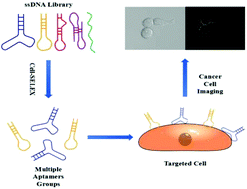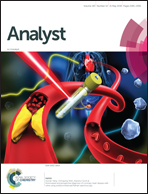DNA aptamers from whole-cell SELEX as new diagnostic agents against glioblastoma multiforme cells†
Abstract
Glioma is a cancer derived from transformed glial cells, which are often invasive and display a heterogeneous cell population. Currently, no trustworthy biomarkers for the detection and risk stratification of glioma have been discovered. The objective of the present research was to select DNA aptamers to facilitate early diagnosis and effective therapy of glioma. Using cell-SELEX, three aptamers (WYZ-37, WYZ-41, WYZ-50), which can specifically recognize the molecular differences between target cells T98G and negative cells SVGp12, were identified. The best binding sequences WYZ-41 and WYZ-50 were optimized in length, resulting in aptamer sequences WYZ-41a and WYZ-50a. The Kd values of the aptamers WYZ-41a and WYZ-50a against the target cell line were found to be 1.0 ± 0.2 nM and 2.8 ± 0.6 nM, respectively, which are better than the Kds for full-length aptamers WYZ-41 and WYZ-50. Flow cytometry analysis results show that the aptamers WYZ-41a and WYZ-50a do not influence each other in mutual binding, and that they effectively detect the target even in complex mixtures, such as undiluted fetal bovine serum (FBS) and cerebral spinal fluid (CSF), indicating that aptamers WYZ-41a and WYZ-50a have excellent potential as aptamer pairs to improve the accuracy of glioma diagnosis.

- This article is part of the themed collections: Analyst Recent HOT articles and Recent analytical chemistry science from China


 Please wait while we load your content...
Please wait while we load your content...